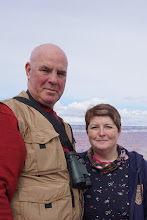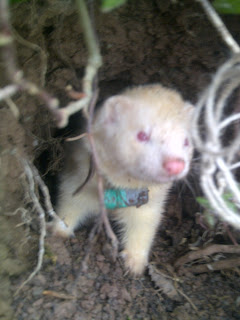New
Ferret Entered.
Went to
try a few holes at a friend's place today, lots of rabbit sign but none
present in the small buries there. There is lots of cover so I
assume they are staying above ground except to escape foxes or just running through to play. After
running my experienced jill through a small bury, I introduced my new
ferret, born last summer, to a small hole at the bottom of the bury,
she went down with now hesitation at all and worked her way through
methodically coming out without hesitation.
Here she is coming out with out a glance backwards. There are few things more annoying than a ferret which
hovers at the entrance and bobs back inside every time you put your
hand down to pick them up. I think the secret of making them willing to march out is plenty of handling and no dogs diving in to scare the fitchuk.
The field was covered with sign that rabbits are there but as soon as they suspect being hunted they dive into an old scrub oak wood, and like brier rabbit they are more than at home in the midst of the bramble patch.
The field was covered with sign that rabbits are there but as soon as they suspect being hunted they dive into an old scrub oak wood, and like brier rabbit they are more than at home in the midst of the bramble patch.
Ferret locators are one of the best
things ever to hit the ferreting world. I well remember the
nightmare of trying trying to use a line hob. Most of the time I
seemed to end up digging him out because he had got the line caught
around something, or had wandered through most of the warren before
finding the jill and dead rabbit. I still have my original Deben
receiver and it works as well ow as when I first bought it some 30
years ago.
When digging down to a ferret, you of course dig to the side and not directly on top as this may cause a cave in or with heavy handed diggers may chop into the ferret. I find that the act of digging will usually get the ferret moving anyway and she can be picked up. Where it is crucial is when the ferret has gotten herself trapped in a hole by killing a rabbit and blocking the hole. A ferret has to be dug up fairly quickly as the heat build up and danger of suffocation increases with time. Season is coming to an end again, and once again I have not spent enough time working my ferrets, but there is always next year.
When digging down to a ferret, you of course dig to the side and not directly on top as this may cause a cave in or with heavy handed diggers may chop into the ferret. I find that the act of digging will usually get the ferret moving anyway and she can be picked up. Where it is crucial is when the ferret has gotten herself trapped in a hole by killing a rabbit and blocking the hole. A ferret has to be dug up fairly quickly as the heat build up and danger of suffocation increases with time. Season is coming to an end again, and once again I have not spent enough time working my ferrets, but there is always next year.


